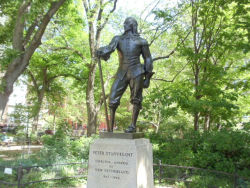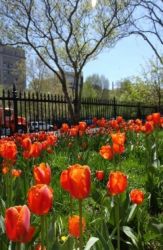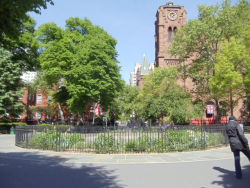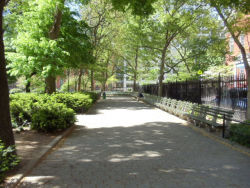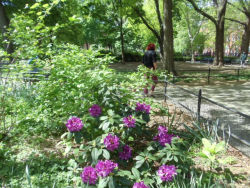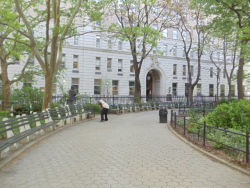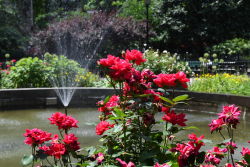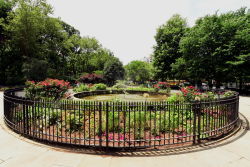Stuyvesant Square
Stuyvesant Square
What was here before?
In the 1660s, this site was part of Peter Stuyvesant’s Great Bouwerie which extended from 23rd Street to the north, Sixth Street to the south, Fourth Avenue to the west, and Avenue C to the east. In 1836, Peter Gerard Stuyvesant and his wife Helen (‘Hellen’) Rutherfurd reserved four acres of the family farm and sold it for five dollars to the City of New York as a public park. In a rapidly expanding city, this was a priceless amenity. Stuyvesant Square catalyzed the initial development of this area.
How did this site become a park?
Originally to be called Holland Square, the site remained vacant until an 1839 lawsuit by Stuyvesant, who insisted that this valuable land be made into a public park. Not until 1847 did the City begin to improve the park and erect the magnificent cast-iron fence. In 1850 the landscape, including two fountains, was complete, and the park opened to the public. The opening of St. George’s Church (to the northwest) in 1856 and the Friends Meeting House (to the southwest) in 1861 attracted more residents to the area around the park. In the latter part of the 19th century, Stuyvesant Square was known as an elegant and engaging neighborhood park.
Stuyvesant Square, like so many other city parks, was extensively rehabilitated during the 1930s. The 19th-century plan was modified by landscape architect Gilmore D. Clarke, and public restrooms and other amenities were built. The park reopened in 1937, looking much as it does today. In 1975, the greater neighborhood gained landmark status, recognizing the historical significance of the park and surrounding buildings. Further restoration efforts in 1982 addressed the reconstruction of the two 1884 fountains, the preservation of the cast-iron fence, and the recreation of the original bluestone sidewalks. Renovations between 2006 and 2016 added new benches and restored the decorative cast-iron fence around the site.
In the park’s northwest quadrant, a statue of the last Director-General of New Amsterdam, Peter Stuyvesant (c.1612-1672), sculpted by Gertrude Vanderbilt Whitney for the 1939 NY World’s Fair and unveiled here in 1941, depicts the ancestor of Peter Gerard Stuyvesant.
Another statue sculpted by Ivan Mestrovic in 1963 for Lincoln Center was relocated in 1997 to the northeast corner of the park. It commemorates the renowned Czech composer, Antonin Dvorak (1841-1904), who lived across the street in the house (now demolished) where he wrote the famous From the New World Symphony.
Who is this park named for?
This park is named for Peter Gerard Stuyvesant (1778-1847) who was the co-founder of the New-York Historical Society and one of the richest men in America at that time.
Check out your park's Vital Signs
Clean & Safe
Green & Resilient
Empowered & Engaged Users
Share your feedback or learn more about how this park is part of a
Vital Park System

